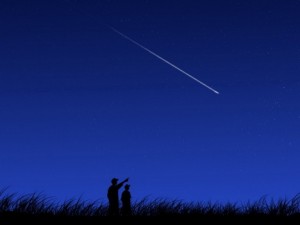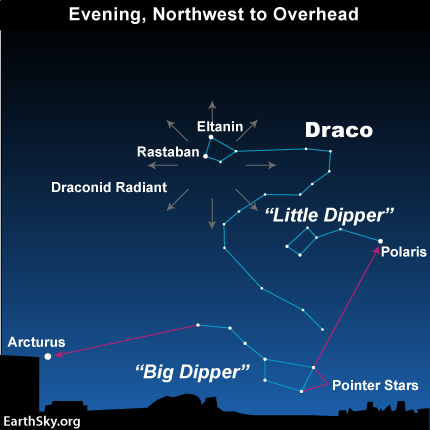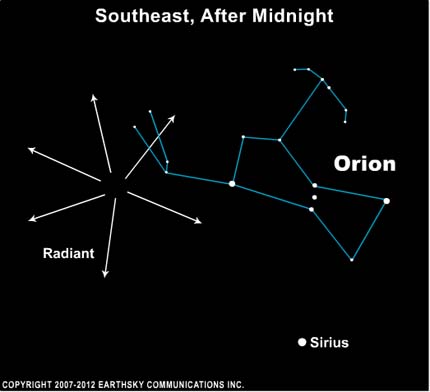
Meteor via Cumbrian Sky
|
October 2013 has two meteor showers. Watch the first in the evening October 7 and 8. The second is best before dawn October 21, but a bright moon interferes
Draconid, or Giacobinid, meteor shower peaks evening of October 7
Orionid meteor shower peaks before dawn October 21

Radiant point of Draconid meteor shower, in the Head of the constellation Draco the Dragon, near the Dragon’s Eyes: the stars Rastaban and Eltanin
Draconid, or Giacobinid, meteor shower peaks evening of October 7. This shower is typically a sleeper, but it has a rich history and has been known to have outbursts. For example, in 2011, observers in Europe saw over 600 Draconid meteors per hour. To our knowledge, no Draconid outburst is predicted for 2013, but sky conditions are good this year for this shower. The Draconid shower peaks on the night of October 7, 2013, when a thin crescent moon sets soon after the sun, leaving the night sky dark for meteor-watching. You might also see some meteors on October 8. Unlike most meteor showers, which are best between midnight and dawn, you can watch the Draconids in the evening. Summary: In 2013, the thin waxing crescent moon won’t cast enough moonlight to interfere with the Draconids. Try watching at nightfall and early evening on October 7 and 8.

The Orionids radiate from a point near the upraised Club of the constellation Orion the Hunter. The bright star near the radiant point is Betelgeuse. In 2013, the Orionids are drowned in bright moonlight, but you still might see a few meteors.
Orionid meteor shower peaks before dawn October 21. There’s a second meteor shower in October, called the Orionids. This year, the Orionid peak on the morning of October 21, 2013, but they will be nearly drowned in the light of a bright moon, during the peak viewing hours. Still, if you’re outside – under a country sky – on the nights around the Orionids’ peak, you might see meteors streaking along in moonlight. Summary: 2013 is not optimal for watching the Orionid meteor shower because a bright waning gibbous moon will be in the sky during the peak hours between midnight and dawn. But you might see some meteors even in bright moonlight. The best viewing for the Orionids in 2013 will probably be before dawn on October 21. Try the days before and after that, too, sticking to the midnight-to-dawn hours. You’ll be watching for those brightest Orionids that can overcome the moon’s glare.
Credit: Deborah Byrd
No comments:
Post a Comment